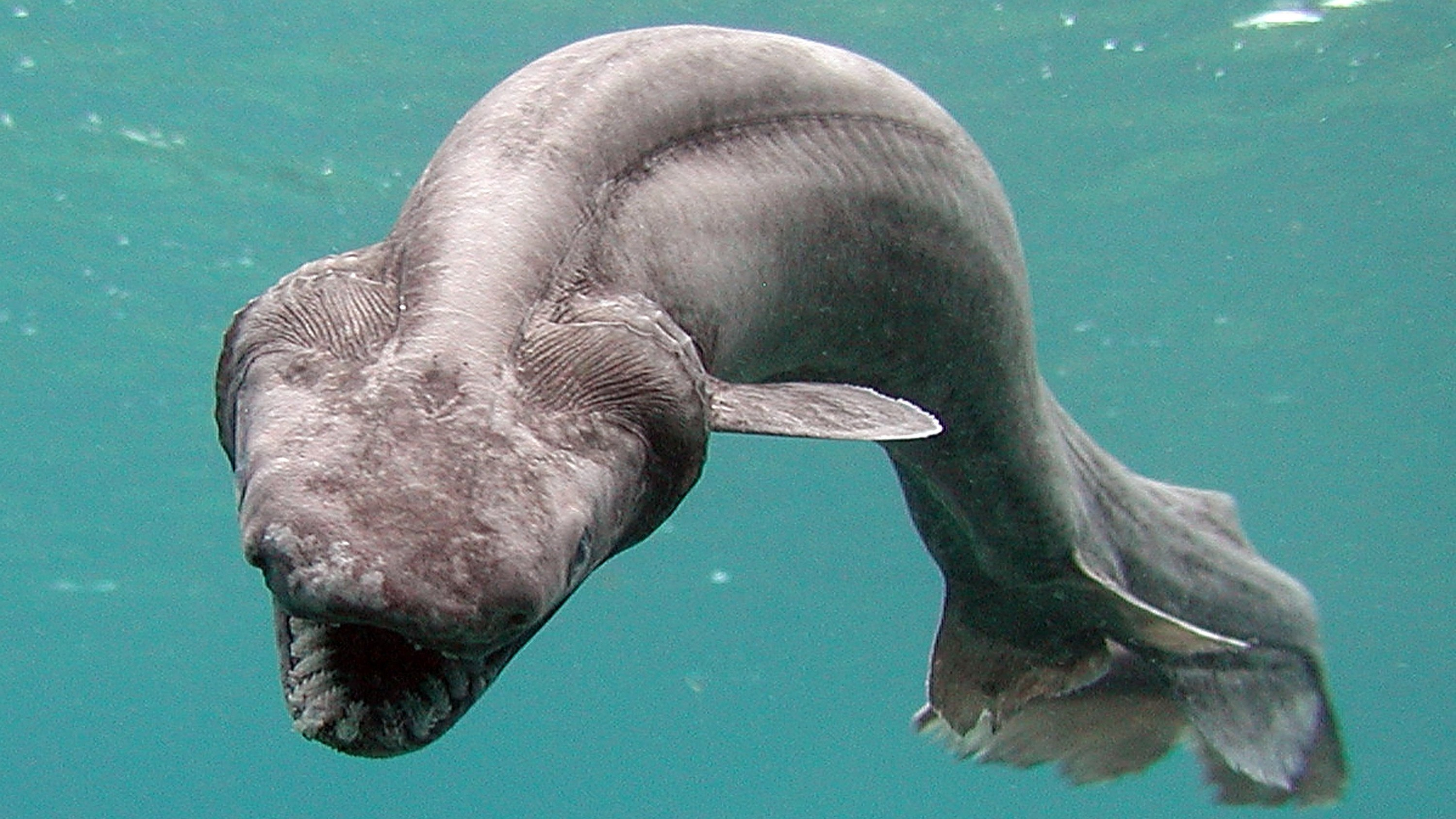
Frilled Shark: Identified
A large fishing boat cruises slowly off the coast of Japan. It sweeps a trawl, a strong net, along the bottom of the deep ocean. At the end of the day, fishers pull the heavy net into the boat. As they inspect the day’s catch, they discover an odd-looking fish. At first they think they have caught an eel. Then they study the fish more carefully. It has a small dorsal fin on its back and frilly gill slits on the side of its head. It is a frilled shark!
The fishers are thrilled to see this uncommon fish up close. They quickly toss it back into the ocean, where it will swim back to deeper waters. Who knows if they will ever see a frilled shark again!
Frilled sharks inhabit the cool coastal waters of the Atlantic, Pacific, and Indian Oceans. They have even been found in the very cold waters off the northern coast of Norway. Frilled sharks usually swim near continental shelves, flat surfaces underwater, at depths between 400 and 4,200 feet (120 and 1,280 meters).
Frilled sharks are medium in size. The average male is between 3 and 4 feet (1 and 1.2 meters) long. Females are larger. Their average length is between 4 and 5 feet (1.2 and 1.5 meters). The largest frilled sharks can measure over 6 feet (1.8 meters) long.
The frilled shark is one of the oldest shark species alive today. It is considered a living fossil because it has changed little over time. This means it has many of the same physical characteristics as sharks that lived 200 million years ago. The frilled shark has a small dorsal fin and an anal fin set far back on its body. These fins help the shark stay balanced. Two short pectoral fins shaped like paddles allow the shark to steer. The frilled shark moves forward when it sways its long, wispy caudal fin from side to side.
The frilled shark has a slinky brown body, a rounded snout, and a large mouth. Most modern types of sharks have five pairs of gill slits. The frilled shark has six. The gills wrap around the shark’s throat like a frilly collar. Unlike most modern sharks, the frilled shark’s snout does not extend over its mouth. Instead, its mouth is located at the front of its head.
Frilled Shark: Tracked
Frilled sharks are ovoviviparous. Babies develop in eggs inside the mother’s body. As they grow, they receive food and nutrients from a yolk sac that is attached to their bodies. The frilled shark may have a gestation time that lasts more than 3 years; that means it takes more than 3 years to develop a baby in its stomach! This is one of the longest gestation times in the animal kingdom. Mothers then give birth to 2 to 12 pups. The average litter size is 6. At birth, each pup measures between 16 and 24 inches (40 and 60 centimeters).
Frilled sharks mature and grow slowly. Most are fully grown before they can reproduce. Researchers suspect that mature frilled sharks seek mates year-round. However, they still do not know how long frilled sharks live.
The frilled shark has a mouthful of small needle-sharp teeth arranged in rows. About 25 separate rows fill both the upper and lower jaws for a total of nearly 300 teeth. Each tooth has three sharp points that curve inward. The pointy teeth are like hooks that trap squids and octopuses, the frilled shark’s favorite prey. A variety of fish, including other sharks, are also on the menu. The frilled shark opens its jaws wide to swallow prey larger than itself.
Because of its deep-sea habitat, little is known for sure about the frilled shark’s eating habits. Scientists believe that it hunts for prey along continental shelves and in underwater caves. Lateral lines along the shark’s body help it detect the movements of prey. A large oil-filled liver keeps the shark buoyant and allows it to float motionless.
When prey swims near, the frilled shark is thought to strike like a snake. Its gill slits may close to help the shark suck prey into its mouth. The shark then uses all of its teeth to grasp the slippery food. Instead of chewing its meal, the frilled shark likely swallows prey whole.
Frilled sharks are considered harmless to people. They swim in waters too deep for swimmers and divers. People rarely encounter them in their natural habitat. The only injuries caused by frilled sharks are accidental. A few scientists have cut their hands on the sharp teeth as they examined the sharks in research labs. Those who handle frilled sharks must be careful!
Frilled Shark: Current Status
Nobody knows how many frilled sharks live in the ocean. No matter the number, most experts believe that deep-sea fishing could be a threat to this shark. Frilled sharks can end up as bycatch on lines and in trawls meant for other fish. They are either thrown back into the ocean or used for their meat.
Many scientists worry that this rare shark is especially at risk because it does not reproduce often. For this reason, the International Union for Conservation of Nature (IUCN) has given the frilled shark a near threatened rating.
Researchers still have much to learn about the frilled shark’s life in the deep ocean. Because frilled sharks cannot live long in captivity without freedom, researchers must study their behavior in the wild. Diving into the deep waters where frilled sharks live is not easy. Researchers must be trained to use special equipment. They must also be able to tolerate swimming in dark, cold waters. The efforts are worthwhile. The more knowledge researchers gain, the more they will be able to protect one of the strangest animals in the world.



 About BeeLine
About BeeLine